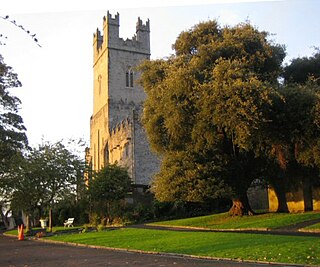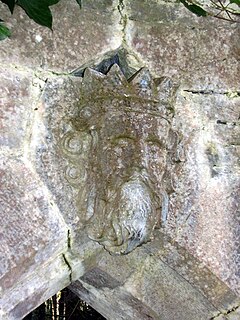| |||||
| Centuries: | |||||
|---|---|---|---|---|---|
| Decades: | |||||
| See also: | Other events of 1168 List of years in Ireland | ||||
Events from the year 1168 in Ireland.
| |||||
| Centuries: | |||||
|---|---|---|---|---|---|
| Decades: | |||||
| See also: | Other events of 1168 List of years in Ireland | ||||
Events from the year 1168 in Ireland.
Domnall Mór Ua Briain, or Domnall Mór mac Toirrdelbaig Uí Briain, was King of Thomond in Ireland from 1168 to 1194 and a claimant to the title King of Munster. He was also styled King of Limerick, a title belonging to the O'Brien dynasty since Brian Boru's annexation of the Norse city in the 10th century.

Saint Mary's Cathedral, Limerick, is a cathedral of the Church of Ireland in Limerick, Ireland which is dedicated to the Blessed Virgin Mary. It is in the ecclesiastical province of Dublin. Previously the cathedral of the Diocese of Limerick, Ardfert and Aghadoe, it is now the central cathedral in the United Dioceses of Limerick and Killaloe.
The Bishop of Roscrea was an episcopal title which took its name after the town of Roscrea in County Tipperary, Ireland.
Amhlaeibh Mac Innaighneorach, Chief Harper of Ireland, died 1168.

Ruaidrí Ua Conchobair was King of Connacht from 1156 to 1186, and High King of Ireland from 1166 to 1193. He was the last High King of Ireland before the Norman invasion.
Donal O'Brien may refer to:
Toirdhealbhach Ua Conchobhair anglicised Turlough Mór O'Connor / O'Conor, was King of Connacht (1106–1156) and High King of Ireland.

Domhnall Ua Lochlainn, also known as Domhnall Mac Lochlainn, claimed to be High King of Ireland.
Muircheartach Ua Briain, son of Toirdelbach Ua Briain and great-grandson of Brian Bóruma, was King of Munster and later self-declared High King of Ireland.
Events from the year 1111 in Ireland.
Events from the year 1194 in Ireland.
Ruaidrí Ua Conchobair, called Ruaidrí na Saide Buide was King of Connacht, perhaps twice.
Donald O'Brien may refer to:
Mór Ní Thuathail was a Queen-consort of Leinster as the principal first wife of King Diarmait Mac Murchada. Under Brehon Law, Irish men were allowed more than one wife. King Dermot's second wife was Sadhbh Ní Fhaolain.
The Corcu Baiscind were an early Érainn people or kingdom of what is now southern County Clare in Munster. They descended from Cairpre Baschaín, son of Conaire Cóem, a High King of Ireland. Closely related were the Múscraige and Corcu Duibne, both of Munster, and also the Dál Riata of Ulster and Scotland, all belonging to the Síl Conairi of legend. A more distant ancestor was the legendary monarch Conaire Mór, son of Eterscél, son of Íar, son of Dedu mac Sin.
Domnall mac Ruaidrí Ua Conchobair (1102–1106) was King of Connacht.
Domnall Mór Ua Cellaigh, 42nd King of Uí Maine and 9th Chief of the Name, died 1221.
Conor Myles John O'Brien, 18th Baron Inchiquin is the holder of a hereditary peerage in the Peerage of Ireland.
Mor Ni Conchobair, Princess of Connacht and Queen of Munster, died 1190.
Mor Ní Briain was Queen of Connacht, and died 1218. She was a daughter of King Domnall Mór Ua Briain of Thomond. Domnall's wife was Órlaith Ní Murchadha, Princess of Leinster, daughter of Queen Mor Ui Thuathail and King Diarmaid Mac Murchadha of Leinster.
Events from the year 1102 in Ireland.
Domnall Gerrlámhach, also known as Domnall Gerrlámhach Ua Briain, Domnall mac Muirchertaig, and Domnall Ua Briain, was an obscure twelfth-century Uí Briain dynast and King of Dublin. He was one of two sons of Muirchertach Ua Briain, High King of Ireland. Domnall's father appears to have installed him as King of Dublin in the late eleventh- or early twelfth century, which suggests that he was his father's successor-designate. Although Domnall won a remarkable victory in the defence of the Kingdom of Dublin in the face of an invasion from the Kingdom of Leinster in 1115, he failed to achieve the successes of his father. After his final expulsion from Dublin at the hands of Toirdelbach Ua Conchobair, King of Connacht, and the death of his father, Domnall disappears from record until his own death in 1135. He was perhaps survived by two sons.
Domnall Ua Briain and Domhnall Ua Briain may refer to: